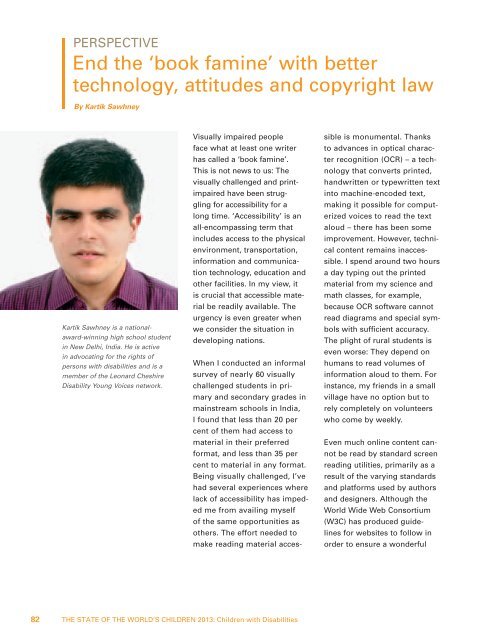Children with Disabilities
Children with Disabilities
Children with Disabilities
Create successful ePaper yourself
Turn your PDF publications into a flip-book with our unique Google optimized e-Paper software.
82<br />
PERSPECTIVE<br />
End the ‘book famine’ <strong>with</strong> better<br />
technology, attitudes and copyright law<br />
By Kartik Sawhney<br />
Kartik Sawhney is a nationalaward-winning<br />
high school student<br />
in New Delhi, India. He is active<br />
in advocating for the rights of<br />
persons <strong>with</strong> disabilities and is a<br />
member of the Leonard Cheshire<br />
Disability Young Voices network.<br />
Visually impaired people<br />
face what at least one writer<br />
has called a ‘book famine’.<br />
This is not news to us: The<br />
visually challenged and printimpaired<br />
have been struggling<br />
for accessibility for a<br />
long time. ‘Accessibility’ is an<br />
all-encompassing term that<br />
includes access to the physical<br />
environment, transportation,<br />
information and communication<br />
technology, education and<br />
other facilities. In my view, it<br />
is crucial that accessible material<br />
be readily available. The<br />
urgency is even greater when<br />
we consider the situation in<br />
developing nations.<br />
When I conducted an informal<br />
survey of nearly 60 visually<br />
challenged students in primary<br />
and secondary grades in<br />
mainstream schools in India,<br />
I found that less than 20 per<br />
cent of them had access to<br />
material in their preferred<br />
format, and less than 35 per<br />
cent to material in any format.<br />
Being visually challenged, I’ve<br />
had several experiences where<br />
lack of accessibility has impeded<br />
me from availing myself<br />
of the same opportunities as<br />
others. The effort needed to<br />
make reading material acces-<br />
THE STATE OF THE WORLD’S CHILDREN 2013: <strong>Children</strong> <strong>with</strong> <strong>Disabilities</strong><br />
sible is monumental. Thanks<br />
to advances in optical character<br />
recognition (OCR) – a technology<br />
that converts printed,<br />
handwritten or typewritten text<br />
into machine-encoded text,<br />
making it possible for computerized<br />
voices to read the text<br />
aloud – there has been some<br />
improvement. However, technical<br />
content remains inaccessible.<br />
I spend around two hours<br />
a day typing out the printed<br />
material from my science and<br />
math classes, for example,<br />
because OCR software cannot<br />
read diagrams and special symbols<br />
<strong>with</strong> sufficient accuracy.<br />
The plight of rural students is<br />
even worse: They depend on<br />
humans to read volumes of<br />
information aloud to them. For<br />
instance, my friends in a small<br />
village have no option but to<br />
rely completely on volunteers<br />
who come by weekly.<br />
Even much online content cannot<br />
be read by standard screen<br />
reading utilities, primarily as a<br />
result of the varying standards<br />
and platforms used by authors<br />
and designers. Although the<br />
World Wide Web Consortium<br />
(W3C) has produced guidelines<br />
for websites to follow in<br />
order to ensure a wonderful


